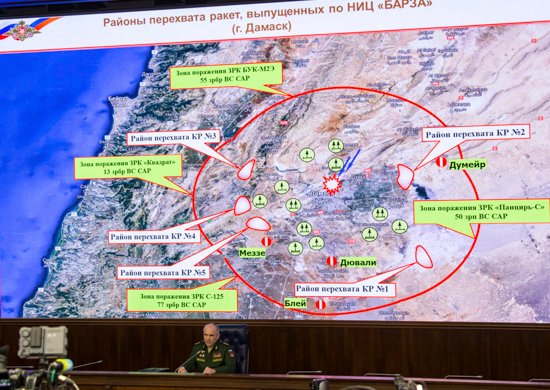
Russia has demonstrated the remains of US missiles shot down in Syria
Chief of the Main Operational Directorate of the Russian General Staff Colonel General Sergei Rudskoy held a briefing for media representatives.
The Russian Defence Ministry continues analyzing missile strike on Syria carried out by the US-led international coalition on April 14 on the eve of arrival of the OPCW representatives in Damascus in order to conduct investigation in Douma, General Sergei Rudskoy said.
According to official statements made by representatives of the United States, Great Britain, and France, the strike was aimed at elimination of alleged production of chemical agents and storages with special munitions of the Syrian party.
In the views of the American, British, and French military departments, this ‘production’ was allegedly concentrated in three objects.

General Sergei Rudskoy
The first object is the Barzah Scientific Studies and Research Center located in Damascus suburbs.
Up to 2013, the Centre conducted researches in the field of development of chemical weapons protection means. Different chemical agents were used there in amounts allowed by the Chemical Weapons Convention.
In 2017, laboratories of the Centre were inspected by representatives of the Organisation for the Prohibition of Chemical Weapons. The inspection showed absence of any activity relating to development and production of poisoning agents.
The second object is underground storage Him Shinshar underground storage located in the province of Homs. Chemical weapons have never been developed or stored there.
The third object is Him Shinshar above ground storage, Homs province. Chemical weapons have never been developed or stored there as well.
In any country, facilities where chemical weapons research is conducted and ammunition is stored are carefully protected because of the great danger to people. However, nothing like was observed at three abovementioned objects. These were the usual buildings and hangars.
Many people who worked there or just idlers arrived there without any means of protection immediately after the attacks. None of them was injured by chemical agents.
In order to determine the level of possible contamination of the terrain as a result of a missile strike and a threat to the civilian population, Russian NBC protection experts took all necessary samples at the Barza facility. Their analysis did not reveal the content of toxic chemicals and poisonous substances on the destroyed site. It was evidenced by the relevant act.
This suggests that this Research Center has not been conducting works with poisonous substances for a long time.
At the same time, the logic of the military and political leadership of the United States, Britain, and France is not clear when choosing these objects for striking.
If, in their opinion, these objects had stocks of poisonous substances, then when striking with cruise missiles large centres of contamination of the terrain could appear. And in the case of Damascus, tens of thousands of people would inevitably be killed.
The United States, Great Britain, and France assess the strikes as successful. They claim that all the missiles hit the assigned targets. At the same time the Research Center in Barzah is allegedly hit by seventy-six cruise missiles, and the storage of Him Shinshar – with twenty-nine cruise missiles. In total, according to the US representatives, 105 missiles were fired.
General Staff of the Armed Forces of the Russian Federation carried out a detailed analysis of the results of the strikes. The collected fragments of missiles, study of shell craters, and the nature of destruction of objects allow us to conclude that no more than twenty-two hits of a hundred and five reported ones have been fixed in the target area.
Only thirteen hits from seventy-six declared ones were found in the area of the Barzah Research Center. This is evidenced by the nature of the destruction of buildings and structures of this Center and completely preserved buildings that are around it at a distance of not more than one hundred meters.
Even if to take into account that explosive of the warhead of the Tomahawk cruise missile ranges from 150 to 200 kilograms, according to the American version, without air-ground missiles fired from two B-1B bombers, not less than eight and a half tons of explosives were to explode in the area of the target. As a result of such an explosion, the Barzah Research Centre was to suffer much more damage. However, it is not observed.
The obtained intelligence and objective monitoring data from air defence systems, work on the ground, and a survey of witnesses show that Pantsyr, Osa, Strela-10, Buk, Kvadrat, and S-125 air defence missile systems, covering the capital of Syria and Duvali, Dumayr, Blai, and Mazzeh nearby airfields of the Syrian Air Force, hit forty-six cruise missiles.
Taking into account trajectories of missiles’ flight and capabilities of the Syrian air defence systems, they were all struck in five interception areas, three of which are located in the west of the Syrian capital, and two ones – to the east.
Fragments of cruise missiles found in these interception areas have characteristic holes from the striking elements of anti-aircraft guided missiles. There are marks with serial numbers, dates and manufacturers, and other data on mechanical units and components. Specialists will be able to easily identify the belonging of these fragments. Some of them are demonstrated at the exposition.
Part of the missiles did not reach the targets, apparently because of technical malfunctions, creating a threat of destruction of civilian objects and the death of civilians. Two of them, including the Tomahawk cruise missile and an air high-precision missile, were transported to Moscow.
Now they are being examined by Russian specialists. The results of this work will be used to improve Russian weapons.
According to Pentagon representatives, 22 missiles hit ground-based structures. The Russian party registered no more than seven hits.
The Him Shinshar underground storage facility, as the US military believes, was struck by seven missiles. According to our intelligence, only two hits were registered.
At the same time, the largest damage to expensive and so-called “smart” missiles was caused to economic buildings that have nothing in common with military activities.
In total, 20 missiles were shot down in three areas of the responsibility zone of air defence of Homs by Pantsyr, Osa, Buk, S-125, and Kvadrat air defence missile systems of the Syrian armed forces.
It is to be noted that most high-precision missiles were shot down by S-125, Osa, and Kvadrat Soviet-made air defence systems.
These systems were recovered and modernized under the auspices of Russian specialists.
The Syrian Defence Ministry analyzed the results of the missile strike. On its basis, a number of changes have already been introduced into the air defence system of the country, which will further increase its reliability.
Russian specialists will continue training Syrian military personnel, as well as assisting in mastering new air defence systems, supplies of which are to be carried out in the near future.
It is to be reminded that the cruise missiles did not enter the Russian air defence systems responsibility zone. The Russian force grouping is ready to repel any air strikes.
Yesterday, at 8.00 p.m., Russian air defence systems detected and shot down two UAVs of insurgents at the distance of 10 kilometers from the Khmeimim airbase.
The strikes carried out by the western coalition did not resulted in disrupting peaceful process in the Syrian Arab Republic.
The Eastern Ghouta recently liberated from militants is returning to peaceful life. In this suburb of Damascus, the authority bodies have been restored; recovery of housing service facilities is underway. Water and electricity supply systems have been recovered in many settlements and towns. Shops are open.
Yarmouk area, southern suburbs of Damascus, is being liberated from terrorist groupings.
Moreover, representatives of the Russian Reconciliation Centre jointly with the Syrian government have reached an agreement with illegal armed formations on voluntary withdrawing from the controlled Eastern Qalamoun.
Over the past four days, 5,495 insurgents and their family members have left Eastern Qalamoun for the north of Syria. State power bodies started working in the area, and infrastructure is being recovered.
In total, 28 tanks, 23 Scud tactical missiles, 35 anti-tank grenade launchers, and a large number of small arms, previously seized from the Syrian army, were handed over to the government troops by the militants. Origin and routes of delivery of west-made weapons to the Damascus region are of particular interest. There are TOW anti-tank guided missiles and others.
The Russian Reconciliation Centre is working on stabilizing the situation and returning of refugees to their homes.
More than 62,000 people have returned to their homes in the Eastern Ghouta.
In total, 9,508 people have returned to Aleppo province via a humanitarian corridor located near Abu Duhur and Tell Sultan from Idlib de-escalation zone.
Under the auspices of the Russian Reconciliation Centre and the Eastern Territories Control Committee, infrastructure is being recovered in Deir ez-Zor province. Since December 2017, 44,501 citizens have returned to their homes on the eastern shore of the Euphrates.
The Russian Federation has been doing everything to establish peace in Syria as soon as possible.


